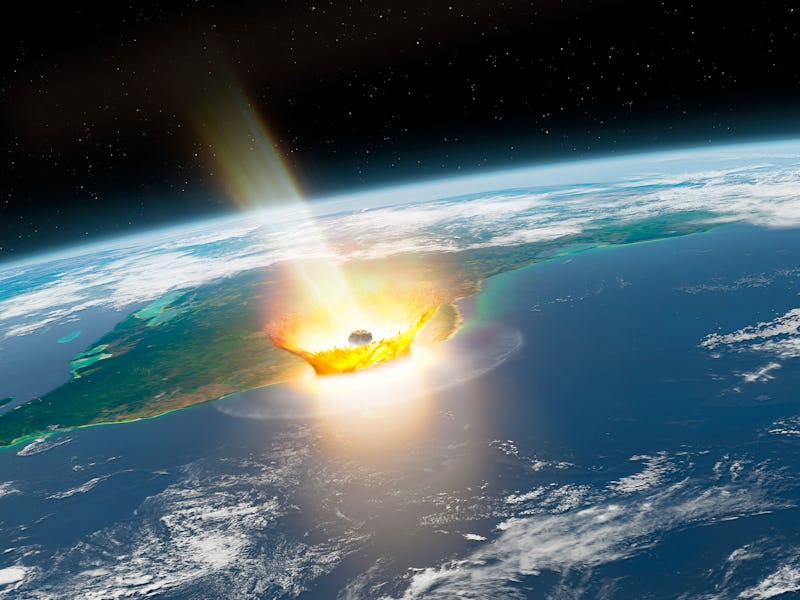Powerful X-Rays Could Save Earth From An Asteroid Collision, A Bizarre New Simulation Suggests
Newton's Second Law to the rescue.

A nuclear bomb might one day deflect an asteroid and save Earth from a disaster.
No, nobody’s remaking Armageddon. It’s a real plan to deflect an incoming asteroid, and a recent lab experiment suggests that it might actually be feasible — not by blowing the asteroid up, but by heating its surface and letting the jets of escaping gas propel it onto a new course. Sandia National Laboratory physicist Nathan Moore and his colleagues published their work in the journal Nature Physics.
This illustration shows the Chicxulub meteor crashing into the Yucatan Peninsula 66 million years ago; this is the sort of thing planetary defense researchers would like to prevent, for obvious reasons.
How it Works
Here’s how the lab simulation went: Before the asteroid could threaten the peaceful blue planet below, a powerful pulse of x-rays rained down on its surface, rapidly heating the rock and the grains of ice trapped inside it. Vaporized rock and ice jetted outward — and just like a rocket thruster, the erupting gas propelled the asteroid in the opposite direction. And there was much rejoicing.
The whole thing seems a bit less dramatic after realizing that the “asteroids” involved were just pebbles, each about a quarter of an inch wide, and the x-ray pulses were proportionally tiny, and the whole action sequence was confined to a small vacuum chamber at Sandia National Laboratory. But the gas, heated by the x-rays and erupting from the pebbles’ surfaces, still accelerated them to around 155 miles an hour.
Moore and his colleagues used extremely thin metal rings to suspend two miniature chunks of rock (one quartz and one silica) in a vacuum chamber, then fired pulses of x-rays at them. The pulses destroyed the metal rings immediately, leaving the miniature asteroids briefly hanging in vacuum just like the real thing — long enough to be hit by the blast and thrust into motion.
When Moore and his colleagues did some math, they found that scaling the whole experiment up meant nuclear weapons could deflect asteroids up to 2.5 miles wide, depending on their makeup (to put that in perspective, the Chicxulub meteor that killed the dinosaurs was about 7.5 miles wide).
Previous experiments with nuclear weapons assumed the powerful shock wave from the nuclear blast would violently shove the asteroid out of the way. But Moore and his colleagues had something else in mind: Nuclear explosions release a lot of radiation, including x-rays. Those x-rays rapidly heat the surface of an asteroid, vaporizing ice, which erupts in sparkling plumes. The erupting gas pushes against the asteroid, just like the thrust from a rocket engine pushes against a spacecraft to change its course.
Something very similar happened when NASA’s DART spacecraft smacked into the asteroid Dimorphos, blasting a plume of debris into space.
“Substantially more momentum was imparted from the material ejecta than from the impact of the DART spacecraft,” Moore and his colleagues write in their recent paper.
Turning an asteroid into an improvised rocket may be a good way to steer it away from Earth; it’s definitely better than just trying to body-check the asteroid away from Earth with an explosion, or an impact with something big and heavy. And Moore and his colleagues suggest that it’s easier to predict the direction and amount of thrust you’re going to get by heating one side of the asteroid with x-rays (from a nuclear bomb detonated in space nearby) than by blasting chunks of rocky debris away with an impact.
According to Moore and his colleagues, that means we’re better off using nuclear bombs to blast an incoming asteroid with x-rays than launching a larger version of NASA’s DART mission.
“Kinetic impactors may be an inefficient defense for the largest asteroids,” Moore and his colleagues write, “especially when warning times are short.”
We’re a very long way from being able to use a nuclear bomb to heat one side of an asteroid and make it change course away from Earth.
What’s Next?
We’re a very long way from being able to use a nuclear bomb to heat one side of an asteroid and make it change course away from Earth, though. Moore and his colleagues tested the idea on extremely tiny, quarter-inch-wide simulated asteroids in a carefully controlled lab. The next step will be to test different materials of various textures (solid rocks will react differently than rubble piles like Dimorphos), and different types of x-ray pulses. And eventually, we’ll need to test the whole thing on a real asteroid in space, probably several times at least, before betting the future of our whole planet.
But Moore and his colleagues say that between their results and the success of DART, there’s reason to be optimistic about our ability to protect our planet in the future.
“Viable test methodologies for both nuclear and kinetic impact deflection strategies now exist,” Moore and his colleagues write. And that’s an important first step.